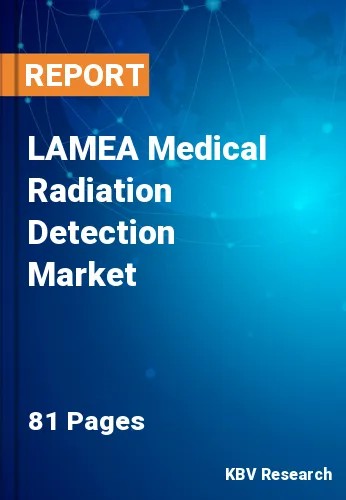The Latin America, Middle East and Africa Medical Radiation Detection Market would witness market growth of 10.6% CAGR during the forecast period (2023-2029).
Medical radiation detection and safety equipment are also necessary for nuclear medicine applications, wherein radioactive tracers are used to diagnose cancer early and track the development of the fatal disease visually using radiopharmaceuticals. Governments are focusing on finding solutions to radiation safety-related problems. The market for medical radiation detection, monitoring, and safety is being driven by this increased demand for safety equipment.
Technology is continually improving throughout the globe to effectively and in real-time defend against the threat & problems of radiation. The measurement of subatomic particles is done with radiation detectors or particle detectors. The particles are a variety of mesons and baryons, as well as protons, electrons, neutrons, alpha particles, and gamma rays. Most detectors use the ionization that is created whenever these particles interact with the material. The growing application of radioactive elements in various fields, including medical imaging, medical research, power generation, industrial processes, and the defense, has sparked concerns about the health of those who use them and are exposed to them somehow.
In Latin America and the Caribbean, it was projected that there would be 1.5 million new instances of cancer and 700,000 cancer-related deaths each year. The equivalent incidence and mortality rates (age-standardized) were 186.5 and 86.6 per 100 000, respectively. Numerous positive coronavirus infection cases have also been reported in nations like Brazil and Argentina. The healthcare and medical services sector is growing in these areas. These nations are heavily reliant on imported medical equipment from developed nations. As a result of the substantial interruption in supply chains, governments have encountered several difficulties with their requirements for medical imaging devices. These factors are propelling the market expansion in LAMEA.
The Brazil market dominated the LAMEA Medical Radiation Detection Market by Country in 2022, and would continue to be a dominant market till 2029; thereby, achieving a market value of $28 million by 2029. The Argentina market is exhibiting a CAGR of 11.2% during (2023 - 2029). Additionally, The UAE market would showcase a CAGR of 10.3% during (2023 - 2029).
Based on Product, the market is segmented into Personal Dosimeters, Area Process Dosimeters, Surface Contamination Monitors and Others. Based on Type, the market is segmented into Gas-filled Detectors, Scintillators and Solid-state. Based on End-Use, the market is segmented into Hospitals, Ambulatory Surgical Centers, Diagnostic Imaging Centers and Homecare. Based on countries, the market is segmented into Brazil, Argentina, UAE, Saudi Arabia, South Africa, Nigeria, and Rest of LAMEA.
Free Valuable Insights: The Worldwide Medical Radiation Detection Market is Projected to reach USD 1.5 Billion by 2029, at a CAGR of 7.7%
The market research report covers the analysis of key stake holders of the market. Key companies profiled in the report include IBA Dosimetry GmbH, Mirion Technologies, Inc., Thermo Fisher Scientific, Inc., LANDAUER (Fortive Corporation), Polimaster Europe UAB, PTW Freiburg GmbH, ATOMTEX, Radiation Detection Company, MP Biomedicals, LLC (Valiant Co. Ltd), and Amray Group Ltd.
By Product
By Type
By End Use
By Country
Our team of dedicated experts can provide you with attractive expansion opportunities for your business.

